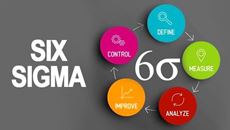- Delivery Method Online
- Professional Certificate
- 24hrs Suggested Study Time
- 3 Months Access
- Tutor Support
- Study On Any Device
- 795 Students
Manufacturing Fundamentals

Learn the basic skills required to work in the manufacturing field.
Learn the basic skills required to work in the manufacturing field. Discover the role of production design, process planning, and the heart of 13 different manufacturing processes. Understand why facility location and plant layout decisions are so vital and learn how job design helps you accomplish company goals and achieve worker satisfaction. Find out what makes up the physical work environment and learn how to characterise different types of production materials. Master product development concepts such as the voice of the customer (VOC), quality function deployment (QFD), and failure mode and effects analysis (FMEA). Learn how performance measurements and standardisation improve manufacturing operations.
In this instructor-facilitated online course, you will learn how successful organisations use costs to communicate manufacturing progress and how to effectively develop short and long-term budgets. Also, you will discover how the application of technology turns an ordinary company into a high-performing organization. You will also find out how ISO 9000 and enterprise resource planning (ERP) make the most of a manufacturer's potential.
Courses are delivered to you through expertly executed lessons, online instruction and interaction with like-minded students. Our courses are designed to deliver all of the benefits of studying in a classroom whilst giving you the flexibility to study at a time and place to suit your needs. You can access your classroom 24/7 from any device with an internet connection.
This course has a 3 month duration. You'll complete comprehensive lessons, quizzes and assignments before submitting your final exam at the end of the course to achieve your certificate. Courses must be completed within the 3 month access period.

Tony Swaim
Tony Swaim has helped many clients, colleagues, and students reach their professional and personal goals. He has been an online instructor since 1998 and has taught at colleges and universities across the United States since 1981. His focus areas ... Read more
Read Tony Swaim's ProfileFrequently Asked Questions
The Learning Environment
From the moment that you enrol in the Manufacturing Fundamentals you will become an integral part of our learning community. You'll find yourself with the freedom to learn at a speed that suits you, on any device, from anywhere in the world. Achieving your career goals no longer has to mean compromising family and work commitments.
Ready to get started?
Enrol NowOur Values
Learn At Your Own Pace
We believe in personalised learning. That's why we provide all the tools and support you need to succeed at your own pace. With flexible learning, you'll stay motivated and retain more information. Plus, you can balance your studies with work and family commitments to make your dreams a reality.
We Won't Break The Bank
Education should be accessible to anyone who wants to learn. That's why we offer some of the most competitive prices in the industry with payments plans for just $25 per week. Investing in your future is a smart choice and doesn’t have to break the bank.
Industry-Led Courses
There's no better way to learn than from experts with years of experience in your field. That's why each of our 200+ industry-led courses are designed to give you a real-life perspective on your industry. With our expert mentors, you'll learn from people who have a wealth of knowledge and experience, and who are passionate about sharing it with you.
Get The Personal Support You Deserve
At Vibe Learning, we're real people who are dedicated to providing you with personal support every step of the way. Our industry experts are not only professional and knowledgeable but also incredibly passionate about sharing their expertise with you. With their guidance, you'll gain invaluable insights and practical knowledge to help you succeed.
Still looking?
Check out the following courses related to Manufacturing Fundamentals:





